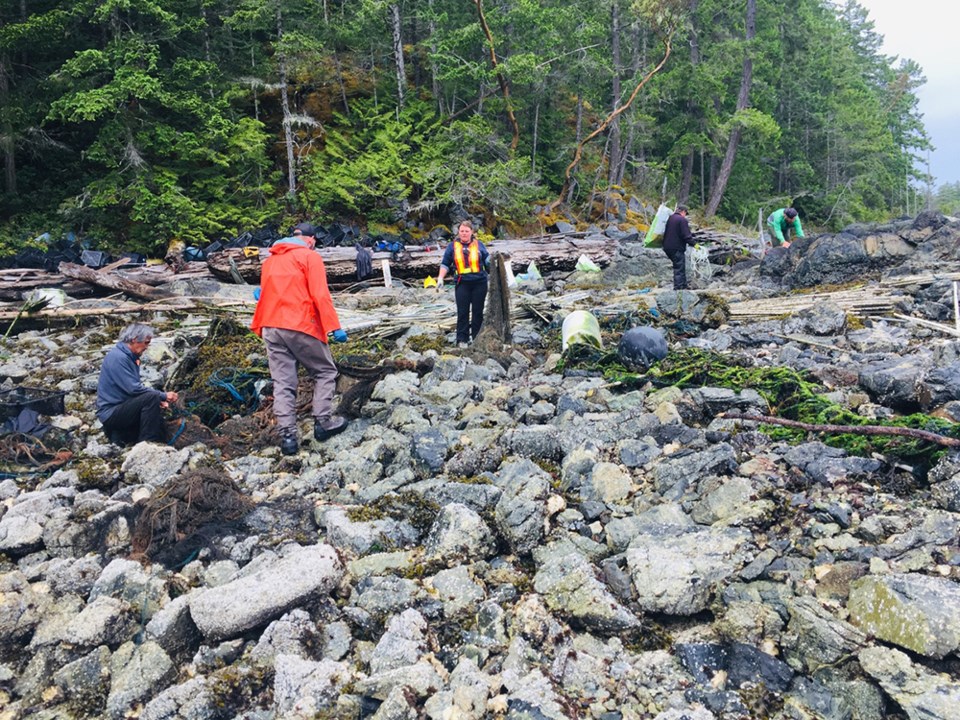Shoreline cleanup throughout qathet Regional District this year amounted to 56.92 tonnes of debris being removed from beaches in seven locations.
According to Let’s Talk Trash (LTT) team member Abby McLennan, this past winter, LTT became aware of a grant funding program for shoreline cleanup initiatives. She said LTT became connected with the Ocean Legacy Foundation and a number of other organizations.
“We all decided to collaborate and do a group application under the umbrella of the Ocean Legacy Foundation,” said McLennan. “We worked on that and found out we were approved near the end of March, which was great.”
She said specifically within qathet Regional District, Let’s Talk Trash put forward five cleanup projects, all of which were approved, and in addition to those five, Ocean Legacy Foundation had a project covering the east coast of Texada Island, and there was also a group cleaning up on Lasqueti Island and in Jedediah Island Marine Provincial Park.
“That fully encompassed qathet Regional District,” said McLennan.
She said LTT projects were south of Powell River in Thunder Bay, on Harwood Island, Savary Island, and in Desolation Sound and Malaspina, Theodosia and Okeover inlets. She added that the project worked closely with Tla’amin Nation and Klahoose First Nation.
“We did a cultural workshop with Tla’amin so that when we were cleaning up different shorelines, and, for instance, found some artifact, we had some idea what historical artifacts look like, and then what to do,” said McLennan. “When we were in areas that were identified as more culturally sensitive, we actually had the Tla’amin watchmen, as well as a member from the Klahoose First Nation, accompany us on the cleanups to make sure we stayed out of the more culturally sensitive areas.
“It was great to work with those folks and hear the stories while out on the cleanups. It was a totally new element that we hadn’t experienced before.”
Funds create jobs
McLennan said with funds that were provided for the seven cleanups, 92 temporary jobs were created to clean the shorelines. She said in the past, funds for shoreline cleanup just covered the bare bones, such as transportation of the materials from these remote locations to the mainland, bin rentals to transport the materials to Augusta Recyclers, and covering disposal and recycling fees.
“With this funding, we were able to pay everybody, so our shoreline cleanup crews were all paid positions,” said McLennan. “We had more access to funding so we were able to spend, instead of one or two days, a full week, and we could get people to commit to that because we were able to pay them.”
Because of the scope of this year’s project, on Savary Island, the crews were able to take away large and difficult to remove items, such as large propane tanks and dock debris that had floated onto the beaches.
“We were able to get a lot of things out of our area that typically wouldn’t be removed because of the resources needed,” said McLennan.
The total number of field days organized for the seven cleanup projects amounted to 91 days.
Recycling results
Of the nearly 57 tonnes of material collected, McLennan said the project was able to divert 31.6 tonnes for recycling. She said a surprising number of beverage containers were picked up, the majority of which were plastic, and there were also finds of Styrofoam, rope and netting, plus hard plastics coming from the aquaculture industry.
McLennan said it’s difficult to get metrics for the collection. She said while it’s easy to weigh the material, the weights don’t always tell the story, because materials such as Styrofoam and some plastics do not weigh much. She said the volume, as a consequence, is substantial, but it’s harder to measure.
All of the materials collected were brought back to Augusta, to the ocean plastics depot. McLennan said the materials were sorted as best they could in the field and then transported back to Augusta, dropped off in front of the depot, and then a final sort was conducted. The materials were weighed and any items that were recyclable were set aside.
City Transfer trucks took trailer loads of the materials down to Ocean Legacy’s marine debris sorting facility in Steveston. McLennan said the goal is to ensure the process is beneficial to the environment and the economy.
“We received a great chunk of money that helped to clean up a lot of stockpiled material on our coastline,” added McLennan. “It’s really challenging to leave the burden of cleanup costs solely on small, coastal communities. It was a very successful program this summer and everyone involved was just so enthusiastic and so hardworking. We really hope the government, once it receives all of the data and results, sees there is a need for more money, and continues with the funding."



